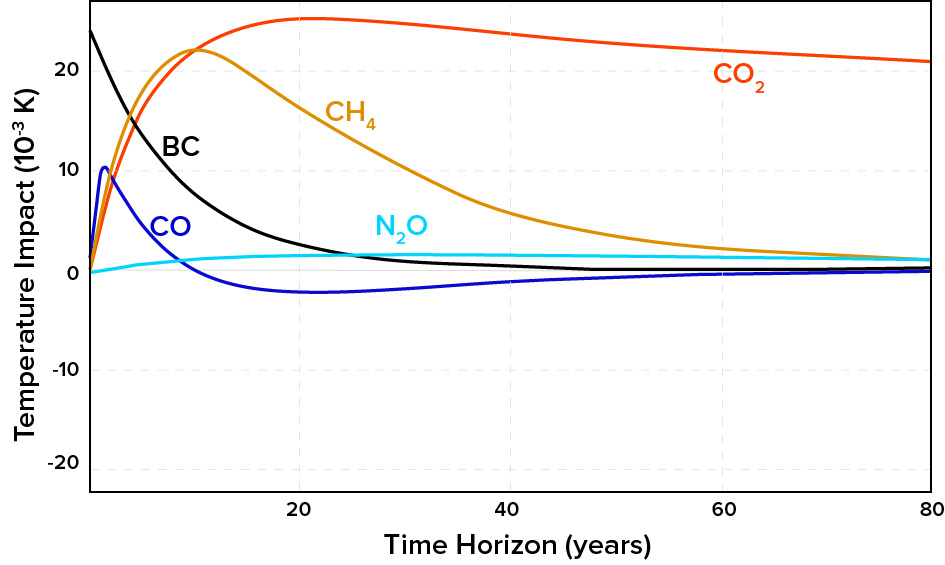Black carbon (BC) – also referred to as soot – is a particulate matter that results from the incomplete combustion of fossil fuels and biomass in industries, vehicles, cooking stoves, residential heating, and gas flaring. It is also emitted during forest fires and agricultural burning. As a major climate and air pollutant, BC emissions have widespread adverse effects on human health and climate change.
BC causes respiratory diseases and increases all-cause mortality. Recent epidemiological studies suggest that exposure to BC in particular, as opposed to undifferentiated particulate matter (PM2.5), can increase the risk of cardiovascular disease by six to twenty-six times, and reducing exposure to BC can increase life expectancy by four to nine times compared to PM2.5.
Globally, exposure to unhealthy levels of particulate matter – including BC – is estimated to cause between three and six million excess deaths every year. Out of 1,000 excess deaths from exposure to PM2.5, about 35 deaths can be attributed to BC alone. Country-level analyses in China, India, and the United States have shown that BC causes thousands of premature deaths every year.
These health impacts of BC are felt disproportionately by those living in low- and middle-income countries, notably in South Asia and sub-Saharan Africa, where solid fuel is used by 2.4 billion people for residential energy. The incomplete combustion of these fuels produces BC and a dangerous cocktail of other pollutants causing household indoor air pollution (HAP) that in some cases exceed World Health Organization (WHO) recommended levels by up to 100 times. Globally, HAP is estimated to cause about half of all the premature deaths associated with air pollution.
By increasing health expenditures and removing people from the workforce, BC has significant economic ramifications. Estimates from China show that in 2017 short-term BC exposure caused economic losses of US$7.5 to $13.2 billion, and long-term exposure led to losses of US$53 to $93.2 billion – equivalent to between 0.4% and 0.8% of China's GDP that year. According to the World Bank, reliance on unclean cooking fuels – the largest source of BC – results in global economic losses in excess of US$2.4 trillion each year.
BC also contributes to climate change through two distinct modes. First, by absorbing solar energy. BC is an extremely potent warming agent with a global warming potential (GWP) estimated to be several times greater than carbon dioxide. Over short timeframes, BC causes more warming than any other climate pollutant as shown in Figure 1.1. According to the Intergovernmental Panel on Climate Change (IPCC) AR6 report, the current warming attributed to BC is roughly 0.1°C when compared to pre-industrial times, although there exists significant uncertainty surrounding this estimate.
Figure 1.1 — Temperature response by component for total anthropogenic emissions for a one-year pulse. In the short term, methane and black carbon dominate warming, while in the long run, carbon dioxide is the dominant warming agent. Reproduced from IPCC AR6 report (Figure 8.33).
Second, BC ends up deposited onto ice which reduces albedo as it absorbs sunlight, thereby increasing snow melt and accelerating climate warming in snow-covered regions. This impact is felt acutely in the Arctic and Himalayas. In the Arctic, where temperatures increased by 1.5°C between 1976 and 2007, it has been estimated that increased atmospheric BC alone may have contributed 0.4°C of warming. Recent findings from the Himalayas and Hindu Kush mountains indicate that over 50 percent of the acceleration in glacier and snow melt can be attributed to BC deposits. In addition, BC emissions have been linked to alterations in the monsoon patterns across the Indian subcontinent and Tibetan Plateau.
1.1 Reducing Black Carbon Emissions: A Win-Win for People and Climate
Reducing BC emissions will have significant human well-being, climate, and economic benefits. Targets to reduce BC have the potential to prevent approximately four to twelve million premature deaths between 2015 and 2030, mostly in South Asia and sub-Saharan Africa.
In sub-Saharan Africa – a hotspot of residential BC emissions – providing clean cooking fuel to reduce BC emissions could avert around 463,000 deaths every year (Figure 1.2). Furthermore, the socio-economic benefits far outweigh the cost of implementation as providing clean cooking fuel to every household in Africa could result in a total net benefit of US$78 billion, mostly in the form of improved health (Figure 1.2).
On average households can save nearly an hour a day by switching to clean fuel (Figure 1.2). This reduction in “time poverty” could provide family members, especially women and girls, the opportunity to pursue education and economic activities.
Figure 1.2 — Co-benefits of implementing clean cooking across sub-Saharan Africa. Data source: Khavari et al 2023.
Transitioning to clean cooking fuel has additional co-benefits. For example, unsustainable wood harvesting for cooking fuel has resulted in deforestation and biodiversity loss in South Asia and sub-Saharan Africa. East African countries such as Eritrea, Ethiopia, Kenya, and Uganda are a major hotspot of depleting sustainable woodfuel resources. In the Democratic Republic of Congo – the largest sub-Saharan country – 84% of harvested wood is used for charcoal or firewood. Therefore, solutions aimed at curbing BC can also reduce deforestation in these regions.
In urban areas, vehicle emissions stand out as a primary contributor to air pollution and the predominant source of BC, irrespective of whether it is a high-, middle-, or low-income country. For example, in the urban megalopolises of Delhi and Nairobi, transportation contributes more than 80% of BC for the majority of months. Similarly, in France and China, studies have shown strong correlations between road transportation and BC concentration. A major difference however between high- and low- and middle-income countries, is the significantly higher concentration of BC in cities in low- and middle-income countries compared to the high income countries.
Reducing BC emissions from transportation has the potential to substantially mitigate related morbidity and mortality, particularly in rapidly expanding urban areas in low- and middle-income countries which are seeing an exponential increase in vehicle demand.
The high short-term GWP of BC means that it can result in immediate climate impacts. The IPCC recommends deep reductions in BC emissions by 2030 to achieve the Paris Climate Agreement goal of limiting warming to below 1.5°C, yet very few countries have addressed BC emissions in their climate plans.
Targeted reductions in BC can also result in regionally important climate improvements. Significant reductions in short-lived climate pollutants – including BC – can reduce Arctic warming between 2041 and 2050 by 0.4°C, which is vital for preserving the region’s ecosystems and avoiding critical environmental tipping points. Similarly, implementing rapid BC emissions reduction policies in South Asia can immediately slow glacier melting in the Himalayas and the Hindu Kush, preserving future water security for billions of people living in the Indo-Gangetic Plains of Bangladesh, India, Nepal, and Pakistan as well as mitigating the associated risks with rapid melting such as floods and landslides.
Additionally, reducing BC goes hand-in-hand with the reduction of other climate and air pollutants such as methane, carbon dioxide, particulate matter, and volatile organic compounds (VOCs). For example, universal access to clean cooking in Africa could lead to an annual greenhouse gas emissions reduction of 586 million tons of CO2-eq – approximately 1% of global yearly emissions.




